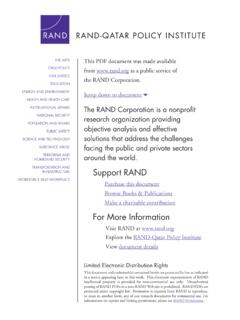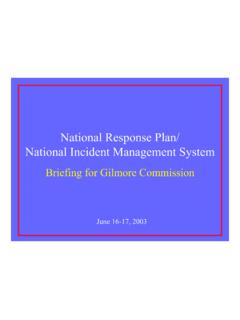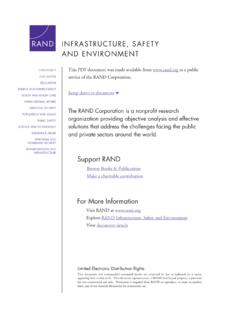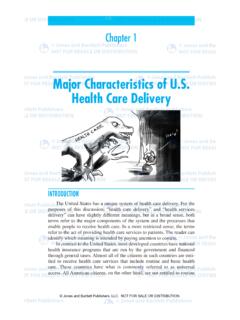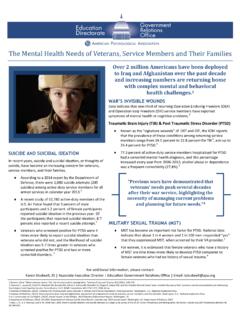Transcription of Mental Health Stigma in the Military
1 Mental Health Stigma in the Military Joie D. Acosta, Amariah Becker, Jennifer L. Cerully, Michael P. Fisher, Laurie T. Martin, Raffaele Vardavas, Mary Ellen Slaughter, Terry L. Schell C O R P O R AT I O N. ELECTRONIC COPIES OF RAND RESEARCH ARE PROVIDED FOR PERSONAL USE; POSTING TO A NONRAND WEBSITE. IS PROHIBITED. THIS PUBLICATION IS AVAILABLE FOR LINKING OR FREE DOWNLOAD AT. For more information on this publication, visit Library of Congress Cataloging-in-Publication Data is available for this publication. ISBN: 978-0-8330-8504-7. Published by the RAND Corporation, Santa Monica, Calif. Copyright 2014 RAND Corporation R is a registered trademark. Limited Print and Electronic Distribution Rights This document and trademark(s) contained herein are protected by law. This representation of RAND. intellectual property is provided for noncommercial use only. Unauthorized posting of this publication online is prohibited. Permission is given to duplicate this document for personal use only, as long as it is unaltered and complete.
2 Permission is required from RAND to reproduce, or reuse in another form, any of its research documents for commercial use. For information on reprint and linking permissions, please visit The RAND Corporation is a research organization that develops solutions to public policy challenges to help make communities throughout the world safer and more secure, healthier and more prosperous. RAND is nonprofit, nonpartisan, and committed to the public interest. RAND's publications do not necessarily reflect the opinions of its research clients and sponsors. Support RAND. Make a tax-deductible charitable contribution at Preface Despite the efforts of both the Department of Defense (DoD) and the Veterans Health Administration to enhance Mental Health services, many service members are not regularly seeking needed care when they have Mental Health symptoms or disor- ders. The research team hypothesized that Mental Health Stigma may be a barrier to Mental Health treatment-seeking among Military service members.
3 Without appropri- ate treatment, these Mental Health symptoms or disorders can have wide-ranging and negative impacts on the quality of life and the social, emotional, and cognitive func- tioning of affected service members. The RAND National Defense Research Institute (NDRI) was asked to inventory and assess Stigma -reduction strategies across both the services and DoD as a whole, to identify strengths and gaps that should be addressed. Informed by this inventory and feedback from an expert panel, NDRI developed a set of recommended priori- ties for Stigma reduction. These recommendations answered such questions as Where are there gaps in Stigma -reduction strategies? What Stigma -reduction strategies seem particularly promising? Which of the current Stigma -reduction strategies should be continued or enhanced? and Where is there duplication or overlap, or alternatively, conflicting messages among current strategies? This report summarizes the findings of this assessment.
4 The contents of this report will be of particular interest to policy- makers in DoD, other command and line leadership, and Mental Health providers and other professionals. This research was sponsored by the Office of the Assistant Secretary of Defense for Health Affairs and the Defense Centers of Excellence for Psychological Health and Traumatic Brain Injury and conducted within the Forces and Resources Policy Center of NDRI, a federally funded research and development center sponsored by the Office of the Secretary of Defense, the Joint Staff, the Unified Combatant Com- mands, the Navy, the Marine Corps, the defense agencies, and the defense Intelligence Community. For more information on the RAND Forces and Resources Policy Center, see or contact the director (contact infor- mation is provided on the web page). iii Contents Preface.. iii Figures.. ix Tables.. xi Summary.. xiii Acknowledgments.. xxv Abbreviations.. xxvii Chapter One Introduction.. 1.
5 Need for an Assessment of the Department of Defense Approach to Stigma Reduction.. 1. Purpose of This .. 2. Methods.. 2. Literature Review.. 2. Microsimulation Modeling of .. 3. Interviews with Program .. 3. Prospective Policy Analysis.. 4. Expert Panel.. 4. Organization of This .. 5. Chapter Two Defining Stigma in the Military Context.. 7. Importance of a Clear Operational Definition and Conceptual Model of .. 7. Definition of Mental Health Stigma in the Military Context.. 8. Conceptual Model of Mental Health Stigma in the Military Context.. 8. Military Context Is .. 11. Public, Institutional, and Social Contexts Are Interconnected but Not Well Understood.. 12. Related Terms Are Often Used Interchangeably but Are, in Fact, Distinct from Stigma .. 13. Stereotype, Prejudice, and Discrimination.. 13. v vi Mental Health Stigma in the Military Barriers to Care.. 14. Stigma Reduction Is One Strategy Used to Promote Treatment-Seeking and .. 14. Chapter Three Prevalence of Mental Health Stigma in the Military .
6 17. Prevalence of Stigma in the Military .. 17. Joint Mental Health Advisory Team 7.. 17. Marines Attending the Combat Operational Stress Control Program.. 20. Navy Quick Poll.. 20. 2011 Department of Defense Health Related Behaviors Survey of Active Duty Military .. 21. Hoge et al. Study of Barriers to Care Among Military Personnel Experiencing Combat .. 22. Survey of Individuals Previously Deployed for Operation Enduring Freedom or Operation Iraqi .. 22. Limitations of Military Measures of Stigma .. 23. Challenges Comparing the Prevalence of Stigma in the Military with That in the General Population.. 24. Conclusion.. 27. Chapter Four Societal Costs of Mental Health Stigma in the Military .. 29. Literature Review to Estimate Stigma 's Impact on Treatment-Seeking.. 30. Regression Analyses to Estimate Stigma 's Impact on .. 31. Exploratory Analyses Examining Other Barriers to Care.. 52. Expert Panel to Vet Model Assumptions and Parameters.. 52. Modeling Societal and Medical Costs.
7 53. Conclusion.. 54. Chapter Five Promising Programmatic and Policy Approaches to Reducing Stigma .. 55. Intervening in the Public and Social Contexts.. 55. Public and Social Context Interventions Tested in Civilian Populations.. 56. Contact with Individuals with Mental .. 56. Training on How to Help Someone in Emotional Distress.. 57. Multimedia Campaigns.. 58. Public and Social Context Interventions Tested in Military Populations.. 58. Intervening in the Institutional Context.. 60. Intervening with People with Mental Health .. 61. Summary of Possible Interventions.. 63. Public and Social Contexts.. 64. Contents vii Military Context.. 64. People with Mental Health Disorders.. 65. Chapter Six Department of Defense Programs to Reduce Mental Health Stigma .. 67. The primary Approach Is a Universal Culture Shift to Promote Mental Health and Treatment-Seeking.. 67. More-Indicated or Targeted Military Stigma -Reduction Programs Are Also Being Implemented.. 70.
8 Identifying and Interviewing Representatives from Stigma -Reduction Programs.. 70. Department of Defense Programs and Policies Target the Military Treatment System.. 71. Department of Defense Programs Target Military Norms, Culture, and Social .. 72. Department of Defense Programs Target People with Mental Health .. 73. Most Stigma Programs Are .. 74. Few Stigma -Reduction Programs Are Being Evaluated.. 74. Suggestions to Augment the Department of Defense's Approach to Reducing Mental Health Stigma .. 75. Lessons Learned from Effective Civilian Programs May Help Improve the Department of Defense Programs Targeting Military Norms, Culture, and Social Context.. 75. Programs Targeting the Individual Context May Help Broaden the Department of Defense's Current Approach.. 76. Conclusion.. 77. Chapter Seven Department of Defense Policies Related to Stigma .. 79. Approach to Prospective Policy Analysis.. 79. Literature Review.. 80. Systematic Assessment of Policies.
9 80. Key Findings from the Content Analysis of Department of Defense Policies.. 83. Conclusion.. 91. Chapter Eight Key Findings and Priorities for Improving the Department of Defense's Approach to Stigma Reduction.. 93. Key Findings from the .. 93. Priorities to Improve Stigma -Reduction Interventions.. 94. 1. Explore Interventions That Directly Increase Treatment-Seeking.. 94. 2. Consider Evidence-Based Approaches to Empowering Service Members with Mental Health Concerns to Support Their Peers.. 95. viii Mental Health Stigma in the Military 3. Design New or Adapt Existing Intervention-Delivery Mechanisms to Minimize Operational Barriers for Service Members Seeking .. 95. 4. Embed Stigma -Reduction Interventions in Clinical Treatment.. 96. 5. Implement and Evaluate Stigma -Reduction Programs That Target Service Members Who Have Not Yet Developed Symptoms of a Mental Health Disorder.. 96. Priorities to Improve Policies That Contribute to Stigma Reduction.
10 97. 1. Provide Better Guidance for Policies in Which a Mental Health Condition or Treatment Prohibits Job Opportunities or Actions.. 97. 2. Review the Stigmatizing Language Identified in Policies to Determine Whether It Should Be .. 97. 3. Offer Incentives for Positive Behaviors That Promote Mental .. 98. Priorities to Improve Research and Evaluation Related to Stigma Reduction.. 98. 1. Continue to Improve and Evaluate the Modifications Made to Existing Programs That Begin to Address Stigma and Other Barriers to Care.. 98. 2. Examine the Dynamic Nature of Stigma and How It Interacts with Internal and External Conditions over Time.. 99. 3. Improve Measures of Prevalence to Improve Tracking of Stigma and Other Barriers to Care.. 100. 4. Review Classified Department-Wide and Service-Specific Policies to Determine Potential Implications for Mental Health Stigma and .. 100. Overarching Priority.. 101. 1. Convene a Task Force to Explore the Tensions Between a Command's Need to Know a Service Member's Mental Health Status and Treatment History and the Service Member's Need for Privacy.

